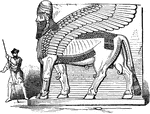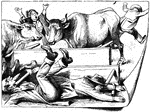Search for "bulls"

Hereford Bull
The hereford bull is used for reproduction of cattle and for beef. Some bulls are used for Spanish traditions.

Egyptian Cattle Doctors
"Cattle doctors are exhibited performing operations upon sick oxen, bulls, deer, goats, and even geese."…

Winged Bull from Nimrud
The Sumerian word lama, which is rendered in Akkadian as lamassu, refers to a beneficient protective…
Sculptured Ornamental Border from the Ruins of Nineveh
Over the Winged Bulls were painted other acts of the king surrounded by his eunuchs and warriors, and…

Capital and Entablature from the Rock Tomb of Darius
The columns in the ruins of Persepolis are circular and slender, and have capitals and bases. The capital…

Ancient Persian Capital
The Ancient Persian capital is a design of the fore-parts of bulls. It is an Old Persian style that…


